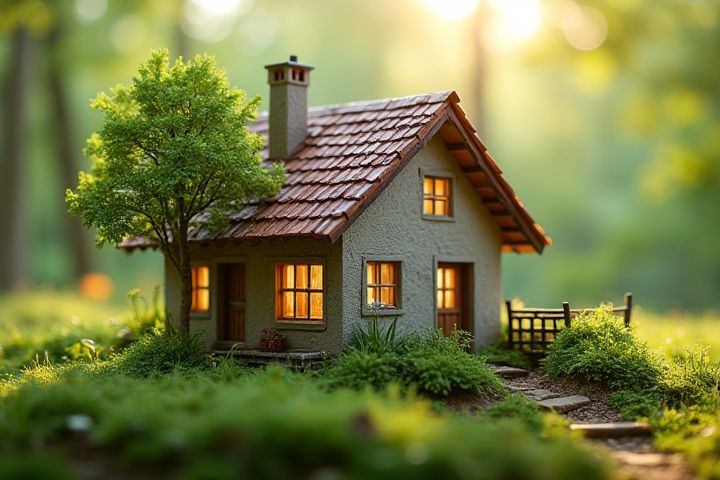
An eco-friendly house incorporates sustainable materials such as bamboo flooring, reclaimed wood, and non-toxic paints, which minimize environmental impact. Energy-efficient appliances and solar panels significantly reduce energy consumption and carbon footprint, promoting renewable energy use. Effective insulation and double-glazed windows enhance thermal efficiency, maintaining comfortable indoor temperatures while lowering heating and cooling demands. Water conservation systems, including rainwater harvesting and low-flow fixtures, contribute to responsible water management. By integrating native landscaping and permeable paving, your property can support local biodiversity and mitigate stormwater runoff.
What Makes A House Eco-Friendly
Energy-efficient appliances
Energy-efficient appliances significantly reduce your home's carbon footprint by consuming less electricity while performing the same functions as standard appliances. For instance, ENERGY STAR(r) certified refrigerators use an average of 15% less energy than non-certified models, resulting in considerable long-term savings on utility bills. Water-efficient dishwashers can save approximately 3,800 gallons of water annually, making a profound impact on resource conservation. By choosing energy-efficient appliances, you not only contribute to a healthier environment but also enhance the comfort and sustainability of your living space.
High-quality insulation
High-quality insulation is essential for an eco-friendly house, significantly reducing energy consumption. Proper insulation materials, such as cellulose or spray foam, can decrease heating and cooling costs by up to 30% annually. Additionally, a well-insulated home minimizes the carbon footprint, contributing to a reduction in greenhouse gas emissions. Ensuring that your home has an insulation R-value of at least 30 in the attic and around 20 in walls will enhance energy efficiency while promoting sustainable living.
Solar panels installation
Installing solar panels is a key feature of an eco-friendly house, allowing you to harness renewable energy from the sun. This technology can reduce your electricity bills significantly, with systems typically saving homeowners between $10,000 to $30,000 over 20 years. Solar panels also decrease reliance on fossil fuels, contributing to a reduction of carbon emissions, with one residential system potentially offsetting about 3 to 4 tons of CO2 annually. Moreover, many local and federal incentives, such as tax credits, can cover up to 26% of installation costs, making this investment not only sustainable but also financially sound.
Sustainable building materials
Eco-friendly houses prioritize sustainable building materials that reduce environmental impact. Common materials include reclaimed wood, which minimizes deforestation and often requires less energy to process, and bamboo, known for its rapid growth and renewability, making it a sustainable choice. Incorporating recycled metal can also enhance the longevity of structures while decreasing waste in landfills. Using low-VOC paints ensures improved indoor air quality, benefiting both occupants and the environment.
Rainwater harvesting systems
Rainwater harvesting systems are a key feature of an eco-friendly house, allowing homeowners to collect and utilize rainwater for various purposes. By capturing rainwater from rooftops, a typical household can save between 30% to 50% of its water consumption, significantly reducing the demand on municipal water supplies. These systems can include storage tanks and filtration devices, ensuring that the harvested water is safe for irrigation and, in some cases, potable use. Implementing rainwater harvesting not only conserves water but also mitigates stormwater runoff, contributing to better local water management and a healthier ecosystem.
Passive solar design
Passive solar design utilizes architectural elements to harness natural energy, significantly reducing reliance on artificial heating and cooling. Techniques include strategic window placement, thermal mass materials, and proper insulation, creating comfortable indoor temperatures year-round. By optimizing sunlight exposure, homes can gain approximately 15% to 30% more heat during winter months. You can enhance energy efficiency and lower utility bills by incorporating features like overhangs and thermal mass elements such as concrete or stone.
Low-flow water fixtures
Low-flow water fixtures significantly contribute to a house's eco-friendliness by reducing water consumption without sacrificing performance. By incorporating showerheads, faucets, and toilets designed to use less water, homeowners can achieve savings of 20% to 60% on their water bills, translating to an average reduction of 7,000 gallons of water usage per year for a typical family. These fixtures not only lower your utility costs but also minimize the strain on local water supplies, making them an essential choice in sustainable living. Opting for ENERGY STAR-rated low-flow options further ensures that your home meets environmental standards while enhancing comfort and efficiency.
Energy-efficient windows and doors
Energy-efficient windows and doors significantly enhance a house's eco-friendliness by reducing energy consumption, which lowers carbon emissions. These installations typically feature advanced glazing systems, such as double or triple panes filled with argon gas, offering thermal insulation that can cut heating and cooling costs by up to 30%. The incorporation of low-emissivity (low-E) coatings minimizes heat transfer while maximizing natural light, contributing to a more sustainable energy profile. You can also select frames made from recycled materials or sustainably sourced wood, further supporting environmentally responsible practices.
Green roofs or living walls
Green roofs, featuring vegetation layered over waterproof membranes, can significantly reduce urban heat, lowering indoor temperatures by up to 30% during hot months. Living walls, comprised of vertical gardens, improve air quality by filtering pollutants and can increase biodiversity, providing habitats for various species. Implementing these features can enhance your home's energy efficiency, potentially reducing energy consumption by 20-50%. Moreover, both green roofs and living walls can capture rainwater, minimizing runoff and decreasing the risk of urban flooding, while offering aesthetic appeal and increased property value.
Smart home technology integration
An eco-friendly house often incorporates smart home technology that optimizes energy efficiency and sustainability. Smart thermostats can reduce energy consumption by learning your schedule and preferences, potentially saving up to 10-15% on heating and cooling costs annually. Automated lighting systems adjust based on natural light availability and occupancy, minimizing unnecessary electricity use. Additionally, smart irrigation systems analyze soil moisture levels and weather forecasts, ensuring your garden receives adequate hydration without wasting water, contributing to a more sustainable living environment.
